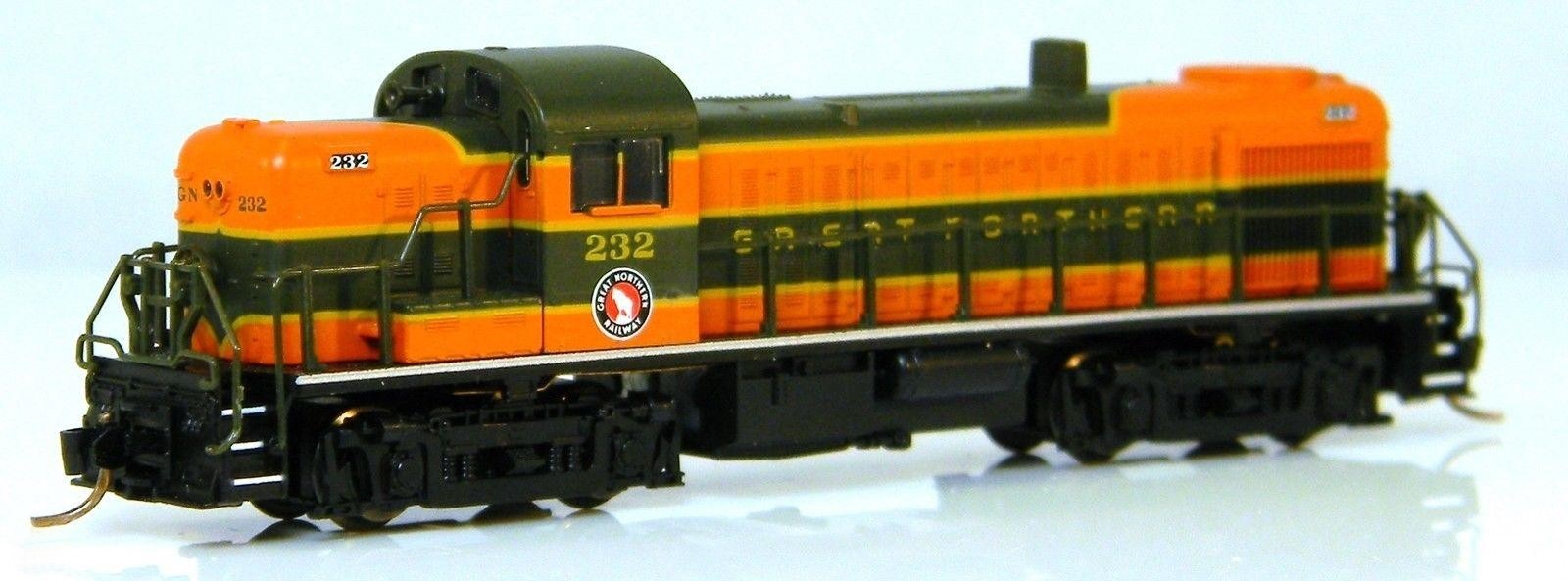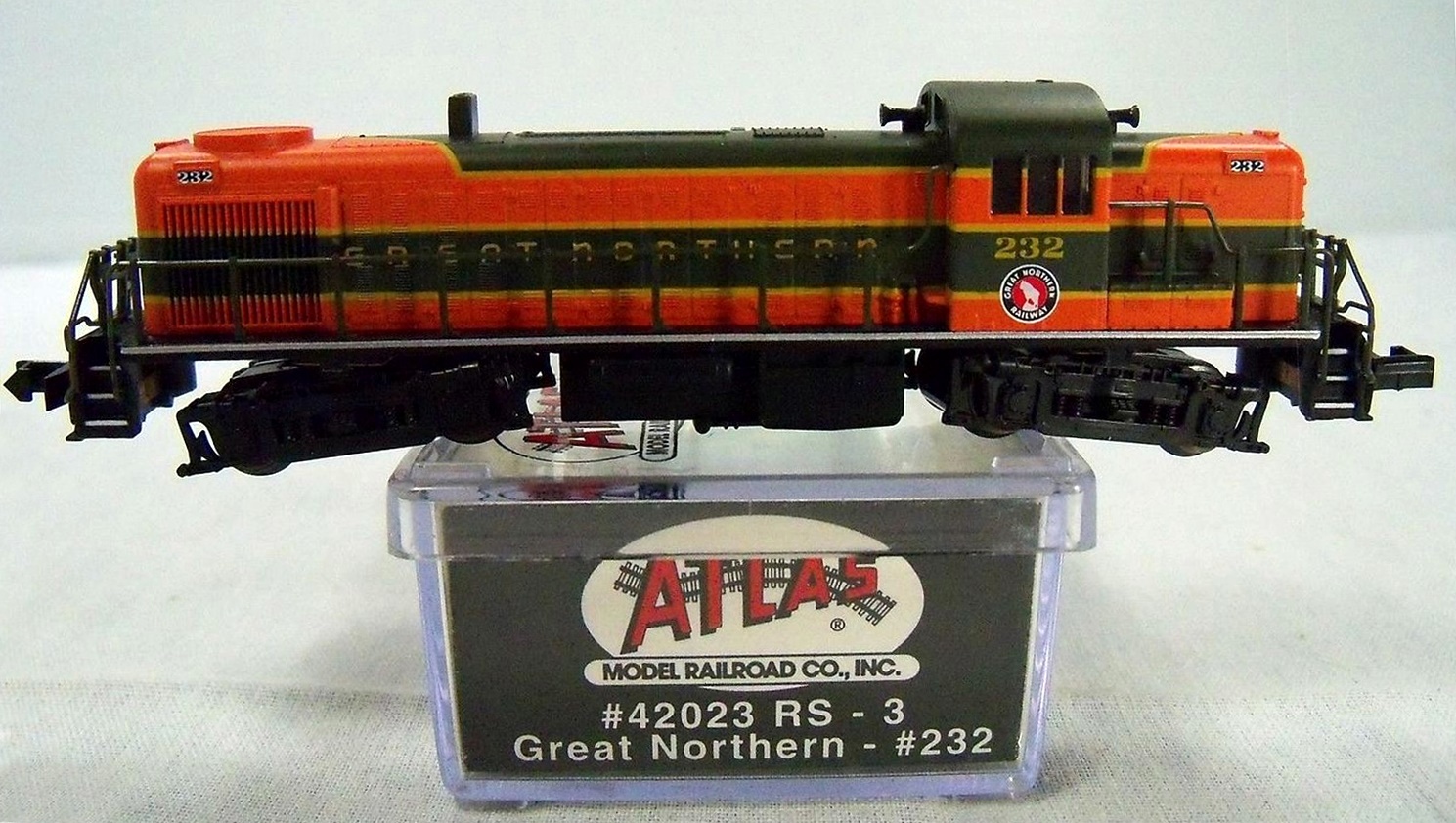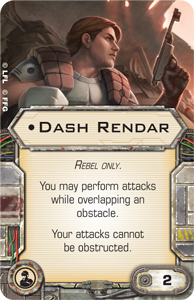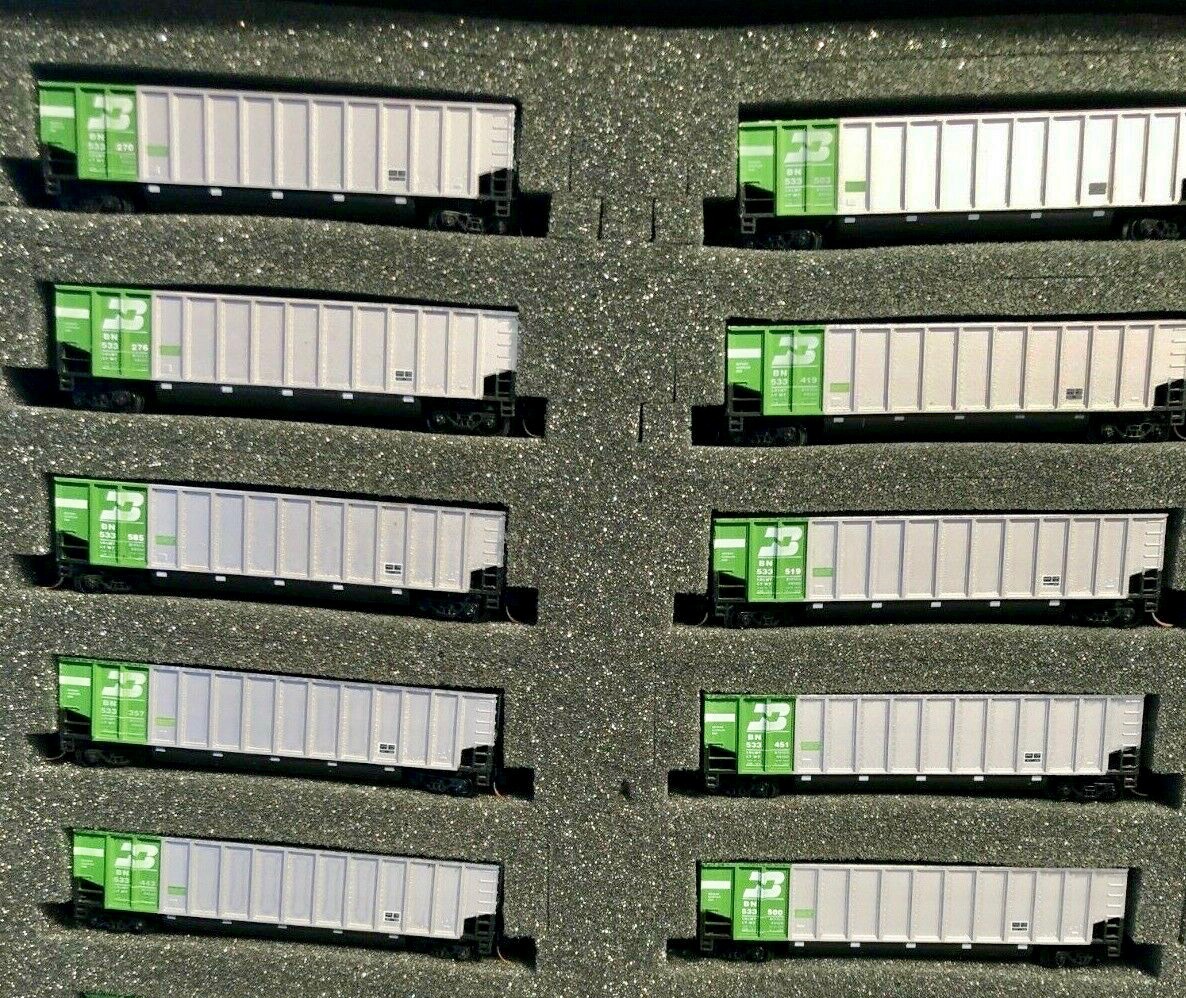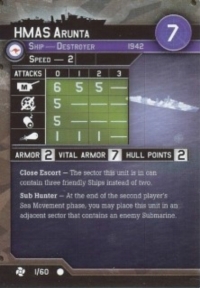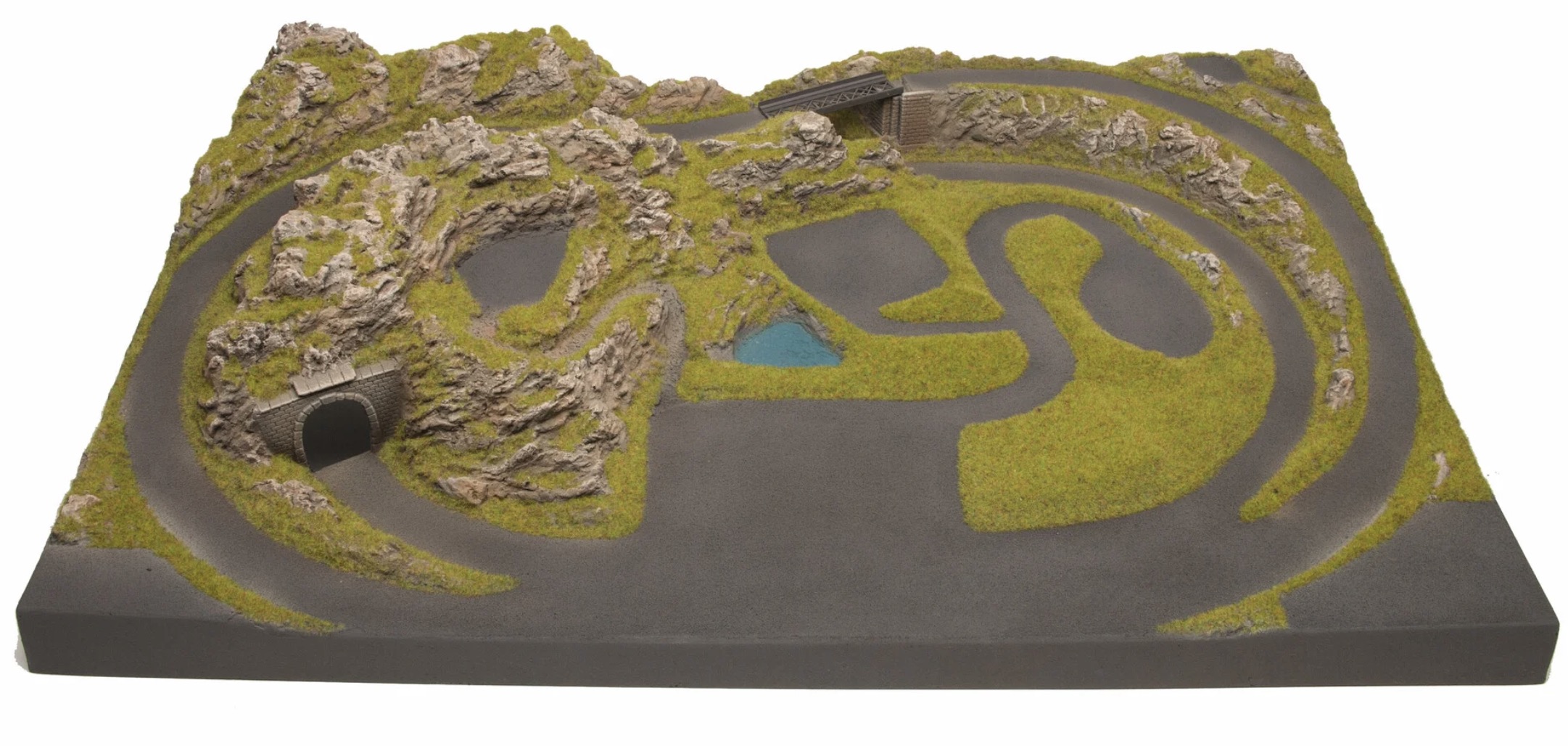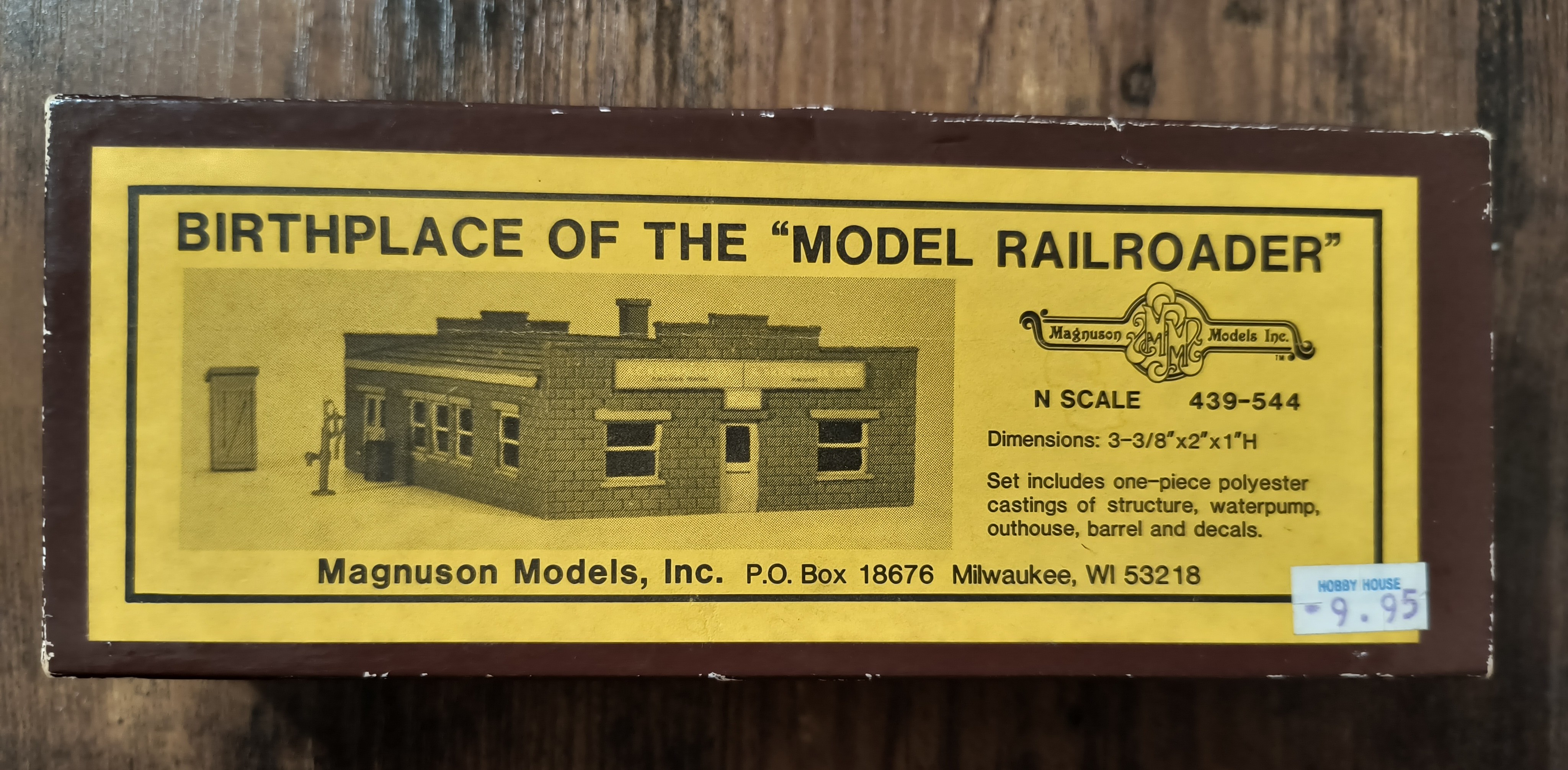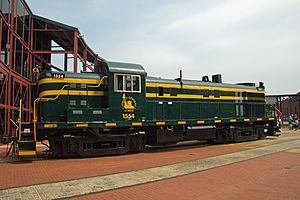Model Information: Atlas introduced the Kato-produced RS-3 in 1983. They followed up with the RSD-4/5 in 1987 (also Kato-produced). Kato also recyled the chassis for use in their RS-11. Atlas redesigned the RS-3 in 1999 and production moved to China. The models were again modified in 2001 (RS-3) and 2004 (RS-4/5) and from then on featured Atlas "Slow-Speed" motors. The Chinese RS-3 and RSD-4/5 share the same internal mechanism.
The early releases were the first locomotive produced by Kato for Atlas. It was vastly superior to the earlier models produced by Roco for Atlas. The combination of the split-frame design, directional lighting and 5-pole motor with bearing blocks to hold the worm gear in place made it the first "modern" N-Scale design for a North American locomotive. The 2001 Chinese version is very similar to the Kato version.
The Atlas-China version features: Golden-white LEDs; Directional lighting; Separately-applied painted handrails (where appropriate); Blackened metal wheels; Scale Speed™ motor and Accurate painting and printing.
The early releases were the first locomotive produced by Kato for Atlas. It was vastly superior to the earlier models produced by Roco for Atlas. The combination of the split-frame design, directional lighting and 5-pole motor with bearing blocks to hold the worm gear in place made it the first "modern" N-Scale design for a North American locomotive. The 2001 Chinese version is very similar to the Kato version.
The Atlas-China version features: Golden-white LEDs; Directional lighting; Separately-applied painted handrails (where appropriate); Blackened metal wheels; Scale Speed™ motor and Accurate painting and printing.
DCC Information: Unfortunately the one modern feature this model lacks is a single-lightboard design to permit a "drop-in" decoder board installation. The split-board requires some soldering and careful installation to upgrade even the most modern edition of this locomotive to DCC. Special split decoders are available to convert these models to DCC. Some soldering required. TCS makes the 1278-CN which works pretty well.
TCS CN decoder installation shown on Brad Myers' N-scale DCC decoder installs blog and on TCS website.
A classical wired DCC decoder detailed installation was available on maritime.dns.ca/mgerrits/trains (website no longer exists).
TCS CN decoder installation shown on Brad Myers' N-scale DCC decoder installs blog and on TCS website.
A classical wired DCC decoder detailed installation was available on maritime.dns.ca/mgerrits/trains (website no longer exists).
Prototype History: Introduced in 1950, the all-purpose, 1600-HSP RS-3 diesel locomotive had the stamina and strength for freight and passenger service yet was agile enough for yard work. With its rugged, dependable design, it's no wonder that many of these versatile RS-3 locomotives are still working today on short lines, tourist lines, and hauling freight. The ALCO RS-3 is a 1,600 hp (1.2 MW), B-B road switcher diesel-electric locomotive. It was manufactured by American Locomotive Company (ALCO) and Montreal Locomotive Works (MLW) from May 1950 to August 1956, and 1,418 were produced - 1,265 for American railroads, 98 for Canadian railroads, 48 for Brazilian and 7 for Mexican railroads. It has a single, 12 cylinder, model 244 engine.
Well over 1,300 RS-3 road-switcher locomotives were built by ALCO between 1950 and 1956. It can be considered one of the most successful four-axle diesel road-switchers ever produced by the builder. These 1,600hp locomotives were powered by an ALCO 244 V-12 engine which was complimented by rugged GE electrical components. The RS-3 was truly a versatile locomotive. It could be found in virtually every type of service from passenger and commuter runs to heavy-haul and local freight assignments. Original owners of the RS-3 tended to be in the eastern and central regions of the US (with heavier concentrations in the northeast and southeast).
During this same time-period, ALCO offered a six-axle road-switcher which was more commonly found in the west. The RSD-4/5 was externally very similar to the RS-3, having six-axle trucks as an obvious spotting feature. They produced the same 1,600hp as an RS-3, but offered increased tractive effort due to the use of a larger generator. Many RSD-4/5s were assigned to operate in mountainous territory (with varying degrees of success) on the Southern Pacific, Santa Fe and the Utah Railway.
Well over 1,300 RS-3 road-switcher locomotives were built by ALCO between 1950 and 1956. It can be considered one of the most successful four-axle diesel road-switchers ever produced by the builder. These 1,600hp locomotives were powered by an ALCO 244 V-12 engine which was complimented by rugged GE electrical components. The RS-3 was truly a versatile locomotive. It could be found in virtually every type of service from passenger and commuter runs to heavy-haul and local freight assignments. Original owners of the RS-3 tended to be in the eastern and central regions of the US (with heavier concentrations in the northeast and southeast).
During this same time-period, ALCO offered a six-axle road-switcher which was more commonly found in the west. The RSD-4/5 was externally very similar to the RS-3, having six-axle trucks as an obvious spotting feature. They produced the same 1,600hp as an RS-3, but offered increased tractive effort due to the use of a larger generator. Many RSD-4/5s were assigned to operate in mountainous territory (with varying degrees of success) on the Southern Pacific, Santa Fe and the Utah Railway.
Road Name History: The Great Northern was born in 1881 with the consolidation of several railroads of the northern plains under the leadership of James J. Hill. By 1893, the mainline from the Great Lakes and the Mississippi River to Seattle was complete.
The GN had two distinctly different characters. The eastern half was a largely flat, grain producing region serving cities like Fargo, the Twin Cities, Grand Forks, Duluth, Sioux Falls, Sioux City and even Winnipeg in Canada. The east end also included the iron ore rich regions of Minnesota. Half of North Dakota was blanketed by GN branchlines (21 in all) serving every imaginable grain elevator.
The western half is the mountainous portion that most people identify with Great Northern. This included crossing the northern Rockies and the even more difficult Cascade ranges. Cities on the western half included Billings, Butte, Helena, Havre, Spokane, Portland, Seattle, and Vancouver. In 1931, a connection to the Western Pacific was completed from Bieber north to Bend, Oregon. This line was disconnected from the rest of the Great Northern. They used trackage rights on the Oregon Trunk and SP&S to bridge the gap. The Cascade Tunnel, the longest on the continent at 7.8 miles, wasn’t completed until 1931. Construction included a massive sluiceway and hydro-electric power station to feed the electrified line through the tunnel and several miles of railroad on either side. This replaced the original Cascade Tunnel which was a third as long but 500 feet higher up the mountain. That replaced the original route that was another 700 feet higher, had 4% grades and 50 miles of snowsheds. All told, Great Northern had about 8,300 route miles.
The steam era was especially unkind to the Great Northern. They seemed to go out of their way to make their locomotives ugly. Belpaire fire boxes were the norm (made famous by the Pennsylvania, made hideous on the GN.) Headlights were often mounted just above center giving them a spinster look. Cab fronts were often at odd angles. The tender coal bunkers were often taller than the engines. But it wasn’t just aesthetics. GN had a knack for buying the wrong engines for the job. 150 Prarie type 2-6-2’s were so unstable at speed that they were busted down to branchline duty almost straight away and none survived after about 1930. Their first 4-8-2 Mountains built for passenger and fast freight were such a disaster, they were rebuilt into 2-10-2’s. Many railroads had built Mountains out of Mikes but no one had ever started with a Mountain and had to build something else from it. The first 2-6-6-2’s were so under-powered, the boilers were used to make Mikados instead. They did manage to build the largest, fastest, and most powerful Mikados in the country however. Their articulated fleet included 2-6-6-2, 2-6-8-0 (later rebuilt into Mikes), 2-8-8-0, 2-8-8-2 types as well as a pair of Challengers originally delivered to SP&S. Many engines were dressed up with green boilers and boxcar red cab roofs.
For the first generation of diesels, GN bought like many large railroads did: a sampling from everyone. Cab and hood units from EMD and Alco and switchers from EMD, Alco, and Baldwin populated the roster. GN’s first generation geeps and SD’s were delivered with the long hood as the front. This included their GP20’s which had high short hoods and the long hood as the front. Aside from an early black scheme for switchers, the GN fleet was delivered in Omaha Orange and green with yellow piping.
Beginning with the arrival of GP30s in 1962, the paint scheme was simplified by dropping the bottom orange band and the yellow piping. For the second generation, General Electric replaced Alco as a supplier of new road engines.
In 1962, some GN freight cars began to appear in Glacier Green which ran along side the vermilion paint adopted in 1956. In 1967, they went for a major shift. Sky Blue, white, and dark gray were joined by a new version of the Rocky the goat logo. There was talk that this would become the paint scheme for Burlington Northern. The GN name and logo was painted on a steel panel bolted the the hand railings of hood units, making it easier to remove after the merger. For whatever reason, they went with green, black and white, a version of which was simultaneously being tested on the Burlington Route. In 1970, Great Northern, Northern Pacific, Spokane Portland & Seattle, and Burlington Route merged to form Burlington Northern.
The GN had two distinctly different characters. The eastern half was a largely flat, grain producing region serving cities like Fargo, the Twin Cities, Grand Forks, Duluth, Sioux Falls, Sioux City and even Winnipeg in Canada. The east end also included the iron ore rich regions of Minnesota. Half of North Dakota was blanketed by GN branchlines (21 in all) serving every imaginable grain elevator.
The western half is the mountainous portion that most people identify with Great Northern. This included crossing the northern Rockies and the even more difficult Cascade ranges. Cities on the western half included Billings, Butte, Helena, Havre, Spokane, Portland, Seattle, and Vancouver. In 1931, a connection to the Western Pacific was completed from Bieber north to Bend, Oregon. This line was disconnected from the rest of the Great Northern. They used trackage rights on the Oregon Trunk and SP&S to bridge the gap. The Cascade Tunnel, the longest on the continent at 7.8 miles, wasn’t completed until 1931. Construction included a massive sluiceway and hydro-electric power station to feed the electrified line through the tunnel and several miles of railroad on either side. This replaced the original Cascade Tunnel which was a third as long but 500 feet higher up the mountain. That replaced the original route that was another 700 feet higher, had 4% grades and 50 miles of snowsheds. All told, Great Northern had about 8,300 route miles.
The steam era was especially unkind to the Great Northern. They seemed to go out of their way to make their locomotives ugly. Belpaire fire boxes were the norm (made famous by the Pennsylvania, made hideous on the GN.) Headlights were often mounted just above center giving them a spinster look. Cab fronts were often at odd angles. The tender coal bunkers were often taller than the engines. But it wasn’t just aesthetics. GN had a knack for buying the wrong engines for the job. 150 Prarie type 2-6-2’s were so unstable at speed that they were busted down to branchline duty almost straight away and none survived after about 1930. Their first 4-8-2 Mountains built for passenger and fast freight were such a disaster, they were rebuilt into 2-10-2’s. Many railroads had built Mountains out of Mikes but no one had ever started with a Mountain and had to build something else from it. The first 2-6-6-2’s were so under-powered, the boilers were used to make Mikados instead. They did manage to build the largest, fastest, and most powerful Mikados in the country however. Their articulated fleet included 2-6-6-2, 2-6-8-0 (later rebuilt into Mikes), 2-8-8-0, 2-8-8-2 types as well as a pair of Challengers originally delivered to SP&S. Many engines were dressed up with green boilers and boxcar red cab roofs.
For the first generation of diesels, GN bought like many large railroads did: a sampling from everyone. Cab and hood units from EMD and Alco and switchers from EMD, Alco, and Baldwin populated the roster. GN’s first generation geeps and SD’s were delivered with the long hood as the front. This included their GP20’s which had high short hoods and the long hood as the front. Aside from an early black scheme for switchers, the GN fleet was delivered in Omaha Orange and green with yellow piping.
Beginning with the arrival of GP30s in 1962, the paint scheme was simplified by dropping the bottom orange band and the yellow piping. For the second generation, General Electric replaced Alco as a supplier of new road engines.
In 1962, some GN freight cars began to appear in Glacier Green which ran along side the vermilion paint adopted in 1956. In 1967, they went for a major shift. Sky Blue, white, and dark gray were joined by a new version of the Rocky the goat logo. There was talk that this would become the paint scheme for Burlington Northern. The GN name and logo was painted on a steel panel bolted the the hand railings of hood units, making it easier to remove after the merger. For whatever reason, they went with green, black and white, a version of which was simultaneously being tested on the Burlington Route. In 1970, Great Northern, Northern Pacific, Spokane Portland & Seattle, and Burlington Route merged to form Burlington Northern.
Brand/Importer Information: In 1924 Stephan Schaffan, Sr. founded the Atlas Tool Company in Newark, New Jersey. In 1933 his son, Stephan Schaffan, Jr., came to work for his father at the age of sixteen. Steve Jr. built model airplanes as a hobby and frequented a local hobby shop. Being an enterprising young man, he would often ask the owner if there was anything he could do to earn some extra spending money. Tired of listening to his requests, the hobby-store owner threw some model railroad track parts his way and said, "Here, see if you can improve on this".
In those days, railroad modelers had to assemble and build everything from scratch. Steve Jr. created a "switch kit" which sold so well, that the entire family worked on them in the basement at night, while doing business as usual in the machine shop during the day.
Subsequently, Steve Jr. engineered the stapling of rail to fiber track, along with inventing the first practical rail joiner and pre-assembled turnouts and flexible track. All of these products, and more, helped to popularize model railroading and assisted in the creation of a mass-market hobby. The budding entrepreneur quickly outgrew the limitations of a basement and small garage operation. Realizing they could actually make a living selling track and related products, Steve and his father had the first factory built in Hillside, New Jersey at 413 Florence Avenue in 1947. On September 30, 1949, the Atlas Tool Company was officially incorporated as a New Jersey company.
In 1985, Steve was honored posthumously for his inventions by the Model Railroad Industry Association and was inducted into the Model Railroad Industry Hall of Fame in Baltimore, Maryland. In addition, Steve was nominated and entered into the National Model Railroad Association Pioneers of Model Railroading in 1995.
In the early 1990s, the Atlas Tool Company changed its name to Atlas Model Railroad Company, Inc.
In those days, railroad modelers had to assemble and build everything from scratch. Steve Jr. created a "switch kit" which sold so well, that the entire family worked on them in the basement at night, while doing business as usual in the machine shop during the day.
Subsequently, Steve Jr. engineered the stapling of rail to fiber track, along with inventing the first practical rail joiner and pre-assembled turnouts and flexible track. All of these products, and more, helped to popularize model railroading and assisted in the creation of a mass-market hobby. The budding entrepreneur quickly outgrew the limitations of a basement and small garage operation. Realizing they could actually make a living selling track and related products, Steve and his father had the first factory built in Hillside, New Jersey at 413 Florence Avenue in 1947. On September 30, 1949, the Atlas Tool Company was officially incorporated as a New Jersey company.
In 1985, Steve was honored posthumously for his inventions by the Model Railroad Industry Association and was inducted into the Model Railroad Industry Hall of Fame in Baltimore, Maryland. In addition, Steve was nominated and entered into the National Model Railroad Association Pioneers of Model Railroading in 1995.
In the early 1990s, the Atlas Tool Company changed its name to Atlas Model Railroad Company, Inc.
Manufacturer Information: 'Atlas Model Railroad' represents the New Jersey manufacturing facility for Atlas brand model railroad products. Atlas also imported European made models in their early years and those items will be noted as having manufacturers set appropriately. In the 1990s Atlas moved all their toolings to China.
Item created by: Alain LM on 2021-11-15 12:43:47. Last edited by Alain LM on 2021-11-15 12:46:01
If you see errors or missing data in this entry, please feel free to log in and edit it. Anyone with a Gmail account can log in instantly.
If you see errors or missing data in this entry, please feel free to log in and edit it. Anyone with a Gmail account can log in instantly.


